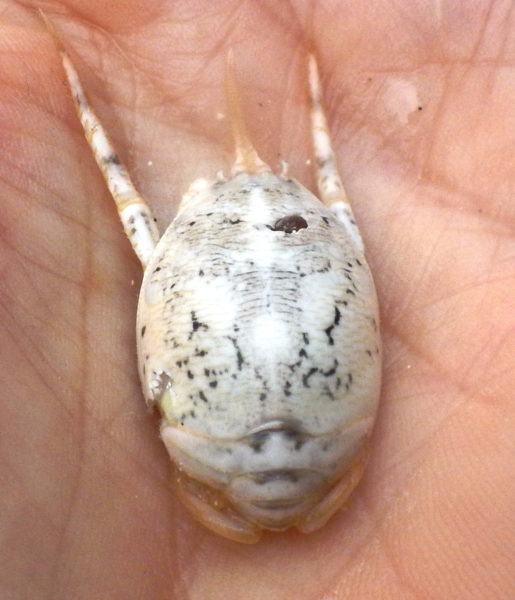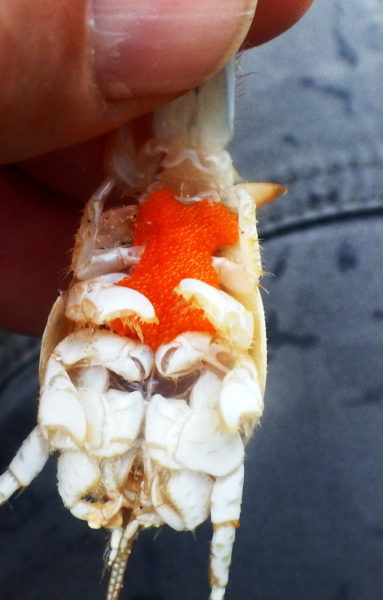Published in the Ocean Watch column, Honolulu Star-Advertiser © Susan Scott
January 14, 2017
One morning last week the news of hate crimes, science denial and war atrocities left me feeling hopeless about the human race. Wanting to block out the whole wretched world, I plugged my ears with headphones, pulled a hat down to my eyes and walked to the beach.
 Tiny mole crabs live in Hawaii, just below the sand and often along the water’s edge.
Tiny mole crabs live in Hawaii, just below the sand and often along the water’s edge.
A deceased female’s belly shows a mass of orange eggs clinging to it.
©2017 Susan Scott
And something wonderful happened. Standing near the shore break, an elderly couple peered down at a tiny white object in the sand.
“We wanted to help it,” the man said, when I approached, “but we didn’t know if it could sting. It seems to be tangled in something orange.”
The creature they were trying to rescue was a charming little mole crab.
Hawaii’s cream-colored mole crabs, about 1.5 inches long, live under the sand along some shore breaks, moving up and down with the tides. The little crabs manage to survive in this turbulent area because their egg-shaped bodies are smooth, allowing water and sand to slide over them with minimal resistance.

With its strong back legs, a mole crab can dig a hole in wet sand and back into it in a split second. This happens so fast that even while watching you can lose the crab’s location. If you know what to look for, though, it’s sometimes possible to find buried mole crabs.
The crabs position themselves upright in their burrows, facing the incoming waves with two stalked eyes peeking out and a pair of feathery antennae lying flat and forward, as a kind of brace. Another pair of plumed antennae stand upright, directing water to the gills for breathing.
All four antennae filter the water washing over them, gathering tiny plants and animals, dead or alive, for food.
The mole crabs’ organs are so tiny, and the wave action so swirly, that the minuscule dimple they make in the sand is barely visible. One easy tell, though, is when a crab has found a
Portuguese man-of-war. Even as waves wash back and forth over the shipwrecked creature, it looks as if its long blue tentacle is stuck in the sand.

It is. A mole crab is reeling it in to eat at its leisure. I’ve found crabs with blue tentacles rolled up on the crab’s belly like a bright skein of yarn.
The mole crab the couple found was alive, but barely. I picked her up, explaining that these filter feeders have no pincers and don’t sting. I say her because the orange mass on the abdomen was a bundle of eggs. Small holes, likely a bite, in the crab’s back proved to be fatal.
To remember those kind people, who not even knowing what it was tried to save a tiny crab’s life, I took the creature home and gave it a photo memorial. The pictures remind me to try to focus on the good side of human beings — and to take more beach walks.